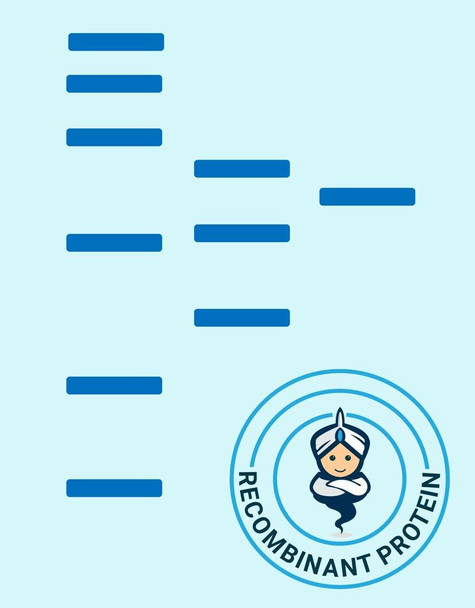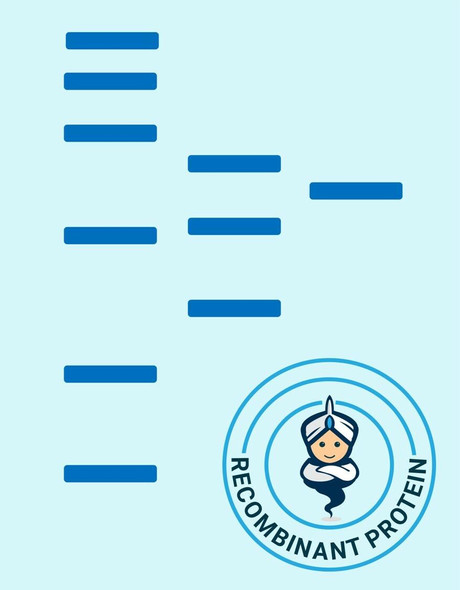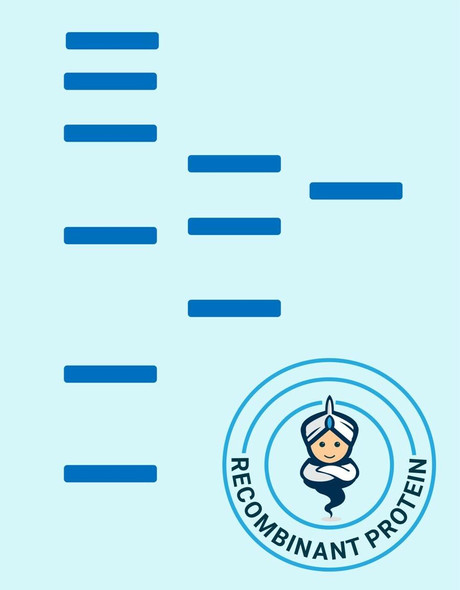Description
| Product Name: | Human PDGF B Recombinant Protein |
| Product Code: | RPPB0838 |
| Size: | 20µg |
| Species: | Human |
| Target: | PDGF B |
| Synonyms: | Glioma-derived growth factor, GDGF, Osteosarcoma-derived Growth Factor, ODGF, SIS, SSV, PDGF2, c-sis, FLJ12858, PDGF-BB, PDGF B-chain, Platelet-derived growth factor beta polypeptide, Becaplermin. |
| Source: | Escherichia Coli |
| Physical Appearance: | Sterile Filtered clear solution. |
| Formulation: | Platelet-Derived Growth Factor-B is supplied in 25mM Na-Acetate pH 4.8, 1mM EDTA and 50% glycerol. |
| Stability: | Store at 4°C if entire vial will be used within 2-4 weeks. Store, frozen at -20°C for longer periods of time. Please avoid freeze thaw cycles. |
| Purity: | Greater than 95.0% as determined by SDS-PAGE. |
The term �PDGF� refers to a family of disulphide bond-linked dimeric isoforms that act as autocrine and paracrine growth factors and are produced by a variety of cell types other than platelets.They act as potent mitogens for almost all mesenchymally-derived cells. Aberrant expression is involved in certain cancers, fibroproliferative disorders and atherosclerosis. The protein also contributes to wound healing and neural regeneration. There are four members of the PDGF family � PDGF A, PDGF B, PDGF C and PDGF D. Two distinct types of PDGF-A exist � a short form that is soluble and a long form that is retained by the extracellular matrix.
PDGF-B Human Recombinant mature chain produced in E.Coli is a non-glycosylated, polypeptide chain containing 109 amino acids fragment (82-190) and having a molecular mass of 16.75 kDa. The PDGF-B is fused with an amino-terminal hexahistidine tag and purified by proprietary chromatographic techniques.
| UniProt Protein Function: | PDGFB: Growth factor that plays an essential role in the regulation of embryonic development, cell proliferation, cell migration, survival and chemotaxis. Potent mitogen for cells of mesenchymal origin. Required for normal proliferation and recruitment of pericytes and vascular smooth muscle cells in the central nervous system, skin, lung, heart and placenta. Required for normal blood vessel development, and for normal development of kidney glomeruli. Plays an important role in wound healing. Signaling is modulated by the formation of heterodimers with PDGFA. A chromosomal aberration involving PDGFB is found in dermatofibrosarcoma protuberans. Translocation t(17;22)(q22;q13) with PDGFB. Belongs to the PDGF/VEGF growth factor family. |
| UniProt Protein Details: | Protein type:Oncoprotein; Secreted, signal peptide; Motility/polarity/chemotaxis; Secreted Chromosomal Location of Human Ortholog: 22q13.1 Cellular Component: Golgi membrane; extracellular space; cell surface; basolateral plasma membrane; endoplasmic reticulum lumen; cytoplasm; extracellular region Molecular Function:collagen binding; identical protein binding; protein binding; protein homodimerization activity; growth factor activity; protein heterodimerization activity; platelet-derived growth factor binding; platelet-derived growth factor receptor binding; superoxide-generating NADPH oxidase activator activity; chemoattractant activity Biological Process: extracellular matrix organization and biogenesis; positive regulation of cyclin-dependent protein kinase activity; nerve growth factor receptor signaling pathway; positive regulation of transcription, DNA-dependent; heart development; positive regulation of fibroblast growth factor receptor signaling pathway; cell projection biogenesis; protein amino acid phosphorylation; positive regulation of MAP kinase activity; monocyte chemotaxis; positive regulation of fibroblast proliferation; positive chemotaxis; transforming growth factor beta receptor signaling pathway; cell growth; positive regulation of mitotic cell cycle, embryonic; response to drug; substrate-bound cell migration; platelet activation; fibroblast growth factor receptor signaling pathway; positive regulation of mitosis; positive regulation of chemotaxis; activation of protein kinase B; positive regulation of blood vessel endothelial cell migration; positive regulation of protein amino acid autophosphorylation; positive regulation of phosphoinositide 3-kinase cascade; positive regulation of peptidyl-tyrosine phosphorylation; activation of protein kinase activity; blood vessel morphogenesis; positive regulation of endothelial cell proliferation; negative regulation of transcription, DNA-dependent; actin cytoskeleton organization and biogenesis; embryonic placenta development; peptidyl-tyrosine phosphorylation; positive regulation of smooth muscle cell proliferation; platelet-derived growth factor receptor signaling pathway; positive regulation of smooth muscle cell migration; response to estradiol stimulus; response to insulin stimulus; platelet degranulation; positive regulation of MAPKKK cascade; positive regulation of glomerular filtration; positive regulation of cell proliferation; response to wounding; hemopoiesis; DNA replication; negative regulation of cell migration; epidermal growth factor receptor signaling pathway; phosphoinositide-mediated signaling; negative regulation of phosphatidylinositol biosynthetic process; positive regulation of phosphoinositide 3-kinase activity; peptidyl-serine phosphorylation; response to hypoxia; innate immune response; blood coagulation; positive regulation of DNA replication; positive regulation of cell migration Disease: Meningioma, Familial, Susceptibility To; Dermatofibrosarcoma Protuberans; Basal Ganglia Calcification, Idiopathic, 5; Basal Ganglia Calcification, Idiopathic, 1 |
| NCBI Summary: | The protein encoded by this gene is a member of the platelet-derived growth factor family. The four members of this family are mitogenic factors for cells of mesenchymal origin and are characterized by a motif of eight cysteines. This gene product can exist either as a homodimer (PDGF-BB) or as a heterodimer with the platelet-derived growth factor alpha polypeptide (PDGF-AB), where the dimers are connected by disulfide bonds. Mutations in this gene are associated with meningioma. Reciprocal translocations between chromosomes 22 and 17, at sites where this gene and that for collagen type 1, alpha 1 are located, are associated with a particular type of skin tumor called dermatofibrosarcoma protuberans resulting from unregulated expression of growth factor. Two alternatively spliced transcript variants encoding different isoforms have been identified for this gene. [provided by RefSeq, Feb 2013] |
| UniProt Code: | P01127 |
| NCBI GenInfo Identifier: | 129724 |
| NCBI Gene ID: | 5155 |
| NCBI Accession: | P01127.1 |
| UniProt Secondary Accession: | P01127,P78431, Q15354, Q6FHE7, Q9UF23, G3XAG8, |
| UniProt Related Accession: | P01127 |
| Molecular Weight: | 241 |
| NCBI Full Name: | Platelet-derived growth factor subunit B |
| NCBI Synonym Full Names: | platelet-derived growth factor beta polypeptide |
| NCBI Official Symbol: | PDGFB�� |
| NCBI Official Synonym Symbols: | SIS; SSV; IBGC5; PDGF2; c-sis; PDGF-2�� |
| NCBI Protein Information: | platelet-derived growth factor subunit B; becaplermin; PDGF, B chain; PDGF subunit B; proto-oncogene c-Sis; platelet-derived growth factor 2; platelet-derived growth factor B chain; platelet-derived growth factor, beta polypeptide (oncogene SIS); platelet-derived growth factor beta polypeptide (simian sarcoma viral (v-sis) oncogene homolog) |
| UniProt Protein Name: | Platelet-derived growth factor subunit B |
| UniProt Synonym Protein Names: | PDGF-2; Platelet-derived growth factor B chain; Platelet-derived growth factor beta polypeptide; Proto-oncogene c-Sis; INN: Becaplermin |
| Protein Family: | Platelet-derived growth factor |
| UniProt Gene Name: | PDGFB�� |
| UniProt Entry Name: | PDGFB_HUMAN |










